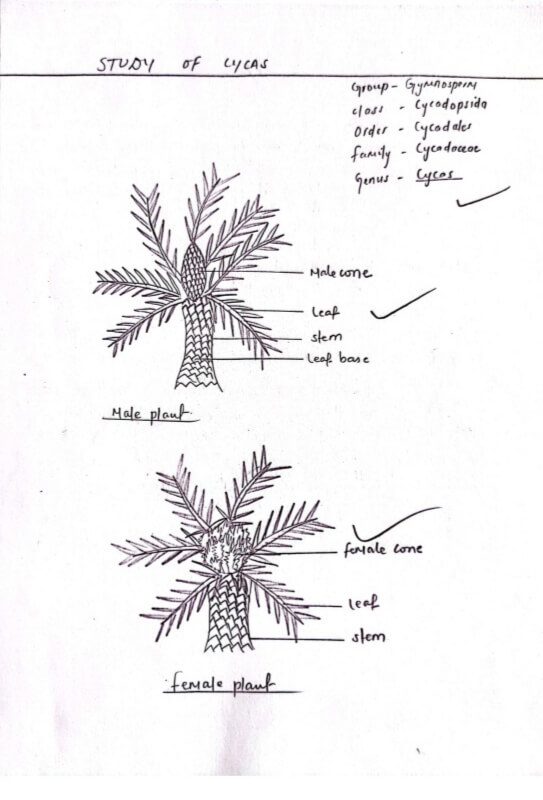COMMENTS ON CYCAS.
Habit
Cycas is a slow growing evergreen gymnosperm found in the wild or cultivated in tropical and sub-tropical parts of the world.
Morphological structures
i) Sporophytic plant:
The plant is differentiated into root, stems and leaf. The stem is a stout unbranched column ranging from 4-3 feet in height. It is covered with armour of thick persistent leaf base.
Male cycas bear male cones and female cycas bear female cones.

ii) Leaves:
The leaves spirally arranged around the stem apex are dimorphic, having brown scale leaves and green foliage leaves. The scale leaves one small, triangular and persistent covered with brownish hairs. The foliage leaves arranged alternately to each other are thick, leathery and bipinnately compound. The rachis is long spring with sheathing base and bears lanceolate unicostate leaflets with pinnules on either side. The margin of leaflets are entirely with spring apex.
iii) Root:
The root is of two kinds – long primary tap root and lateral stumpy dichotomously branched coral-like not called Coralloid roots. They are provided with lenticel, and geotropic in nature, so grow upwards on the surface of soil. They enclose a zone of Anabaena and Nostoc like cyanobacterial alya at their cortical regions.

Internal structure of leaflet
i) Epidermal layers:
There are upper and lower boundary walls composed of single layered compactly arranged thick walled parenchymatous cells. Their external walls are highly cutinized. The lower epidermis at Marginal portion is punctured by sunken stomata.
ii) Hypodermal layer:
The upper epidermal layer is followed by thick walled sclerenchymatous cells which become thick at mid-vein region. The lower epidermis is devoid of sclerenchymatous layers except at the midrib.
iii) Mesophyllous tissue:
It is the region below hypodermis and is differentiated into upper single layered columnar compactly arranged palisade cells containing chloroplast and lower small oval irregular loosely arranged chloroplast bearing spongy cells enclosing many air spaces.
iv) Transfusion tissue:
They are the few layered colourless transversely elongated parenchymatous cells lying between palisade and spongy cells.
v) Vascular bundle:
The vascular bundle shows characteristic diploxylic nature. The central exarch triangular xylem is fan-shaped with the protoxylem facing downward and centripetal metaxylem occupying the base of the triangle facing upwards. On each side of the protoxylem towards the Phloem lie centrifugal metaxylem groups showing mesarch nature of the xylem. The concentric mass of phloem lies below the xylem as an arch.

Sexual reproductive structure
i) Male cone:
The male plant bears a single conical shaped Male cone at the apex of the plant. It consists of a number of microsporophylls spirálly and compactly arranged around the central axis.
ii) Microsporophyll:
Each microsporophyll is a triangular flatten structure with a narrow base terminated into a broad expanded disc drawn out into a projection called apophysis. The upper surface is sterile but the lower surface is fertile.
iii) Female Come:
The female plant bears a crown of rosette- like spirally arranged Megasporophylls at the apex intermingling with the crown of foliage leaves. Each Megasporophyll is a leaf like structure differentiated into three parts, lower stalk, middle fertile axis and upper flattened sterile apex which may pinnately dissected into elongated lobes.
iv) Ovule:
The fertile ports bear at two rows 4-8 yellowish red naked ovules at their notches. The whole megasporophyll is densely covered with brownish hair. The ovules are spherical or ovoid, sessile and orthotropous in their position and vary in size.

